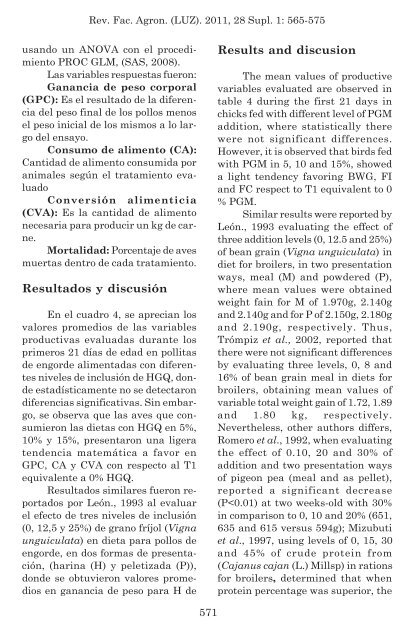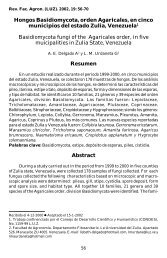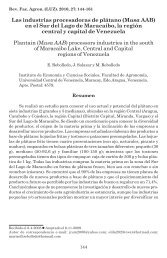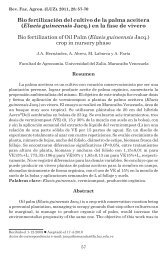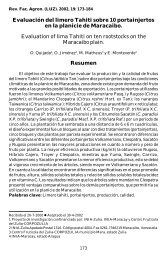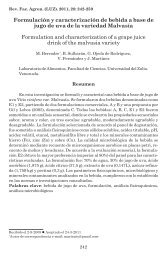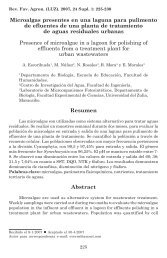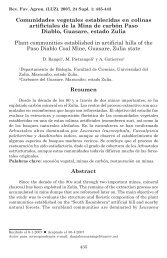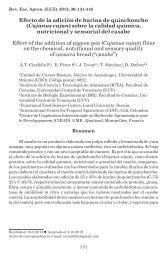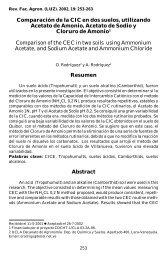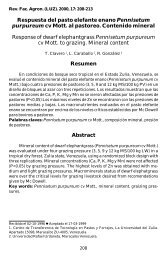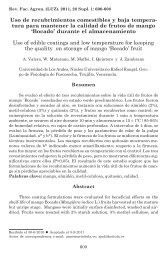Parámetros productivos en pollos de engorde alimentados con ...
Parámetros productivos en pollos de engorde alimentados con ...
Parámetros productivos en pollos de engorde alimentados con ...
You also want an ePaper? Increase the reach of your titles
YUMPU automatically turns print PDFs into web optimized ePapers that Google loves.
Rev. Fac. Agron. (LUZ). 2011, 28 Supl. 1: 565-575<br />
usando un ANOVA <strong>con</strong> el procedimi<strong>en</strong>to<br />
PROC GLM, (SAS, 2008).<br />
Las variables respuestas fueron:<br />
Ganancia <strong>de</strong> peso corporal<br />
(GPC): Es el resultado <strong>de</strong> la difer<strong>en</strong>cia<br />
<strong>de</strong>l peso final <strong>de</strong> los <strong>pollos</strong> m<strong>en</strong>os<br />
el peso inicial <strong>de</strong> los mismos a lo largo<br />
<strong>de</strong>l <strong>en</strong>sayo.<br />
Consumo <strong>de</strong> alim<strong>en</strong>to (CA):<br />
Cantidad <strong>de</strong> alim<strong>en</strong>to <strong>con</strong>sumida por<br />
animales según el tratami<strong>en</strong>to evaluado<br />
Conversión alim<strong>en</strong>ticia<br />
(CVA): Es la cantidad <strong>de</strong> alim<strong>en</strong>to<br />
necesaria para producir un kg <strong>de</strong> carne.<br />
Mortalidad: Porc<strong>en</strong>taje <strong>de</strong> aves<br />
muertas d<strong>en</strong>tro <strong>de</strong> cada tratami<strong>en</strong>to.<br />
Resultados y discusión<br />
En el cuadro 4, se aprecian los<br />
valores promedios <strong>de</strong> las variables<br />
productivas evaluadas durante los<br />
primeros 21 días <strong>de</strong> edad <strong>en</strong> pollitas<br />
<strong>de</strong> <strong>en</strong>gor<strong>de</strong> alim<strong>en</strong>tadas <strong>con</strong> difer<strong>en</strong>tes<br />
niveles <strong>de</strong> inclusión <strong>de</strong> HGQ, don<strong>de</strong><br />
estadísticam<strong>en</strong>te no se <strong>de</strong>tectaron<br />
difer<strong>en</strong>cias significativas. Sin embargo,<br />
se observa que las aves que <strong>con</strong>sumieron<br />
las dietas <strong>con</strong> HGQ <strong>en</strong> 5%,<br />
10% y 15%, pres<strong>en</strong>taron una ligera<br />
t<strong>en</strong>d<strong>en</strong>cia matemática a favor <strong>en</strong><br />
GPC, CA y CVA <strong>con</strong> respecto al T1<br />
equival<strong>en</strong>te a 0% HGQ.<br />
Resultados similares fueron reportados<br />
por León., 1993 al evaluar<br />
el efecto <strong>de</strong> tres niveles <strong>de</strong> inclusión<br />
(0, 12,5 y 25%) <strong>de</strong> grano fríjol (Vigna<br />
unguiculata) <strong>en</strong> dieta para <strong>pollos</strong> <strong>de</strong><br />
<strong>en</strong>gor<strong>de</strong>, <strong>en</strong> dos formas <strong>de</strong> pres<strong>en</strong>tación,<br />
(harina (H) y peletizada (P)),<br />
don<strong>de</strong> se obtuvieron valores promedios<br />
<strong>en</strong> ganancia <strong>de</strong> peso para H <strong>de</strong><br />
571<br />
Results and discusion<br />
The mean values of productive<br />
variables evaluated are observed in<br />
table 4 during the first 21 days in<br />
chicks fed with differ<strong>en</strong>t level of PGM<br />
addition, where statistically there<br />
were not significant differ<strong>en</strong>ces.<br />
However, it is observed that birds fed<br />
with PGM in 5, 10 and 15%, showed<br />
a light t<strong>en</strong>d<strong>en</strong>cy favoring BWG, FI<br />
and FC respect to T1 equival<strong>en</strong>t to 0<br />
% PGM.<br />
Similar results were reported by<br />
León., 1993 evaluating the effect of<br />
three addition levels (0, 12.5 and 25%)<br />
of bean grain (Vigna unguiculata) in<br />
diet for broilers, in two pres<strong>en</strong>tation<br />
ways, meal (M) and pow<strong>de</strong>red (P),<br />
where mean values were obtained<br />
weight fain for M of 1.970g, 2.140g<br />
and 2.140g and for P of 2.150g, 2.180g<br />
and 2.190g, respectively. Thus,<br />
Trómpiz et al., 2002, reported that<br />
there were not significant differ<strong>en</strong>ces<br />
by evaluating three levels, 0, 8 and<br />
16% of bean grain meal in diets for<br />
broilers, obtaining mean values of<br />
variable total weight gain of 1.72, 1.89<br />
and 1.80 kg, respectively.<br />
Nevertheless, other authors differs,<br />
Romero et al., 1992, wh<strong>en</strong> evaluating<br />
the effect of 0.10, 20 and 30% of<br />
addition and two pres<strong>en</strong>tation ways<br />
of pigeon pea (meal and as pellet),<br />
reported a significant <strong>de</strong>crease<br />
(P


